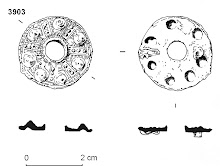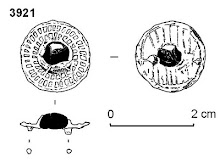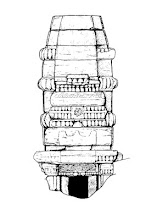Work at the Minories evaluation is now completed, the test pits
have all been backfilled and work on the report is well under way. The evaluation has
given LP Archaeology an excellent insight into the type of deposits on the
site, the range of artefacts, and the environmental conditions. Just as
importantly we now have a better idea of the existing building’s foundations,
and how they have affected archaeological survival, and how they will govern
the excavation methodology.
Natural gravels visible in a sondage through the lowest, organic rich, ditch fills
The deepest test pit was bottomed out on natural gravels at 7.84m below present ground level. We excavated nearly five metres of late 16th and 17th century dumps which had filled the ditch and levelled the ground. There was good survival of organic remains such as wood and leather in the lower fills, and several shoes, including one with a raised wooden ‘kitten heel’, were recovered. We will wait for the spot-dating of the deposits before we can be sure of the exact date of the ditch and its disuse, but it seems clear that the test pit was sited in the middle of probably the latest re-cutting of the ditch. A brief mention by John Stow of the ditch in the late 16th century suggests that there may be timber revetments lining the ditch.
The other test pits were less deep, but still indicate up to
a metre of horizontal archaeological deposits, with large gravel quarries
beneath the horizontal deposits. Above the backfill of one probable quarry a
series of low-energy, ponded silts suggest that the quarries may have been left
open as water-filled features in the post-medieval period. Such quarrying may
have removed most of the Roman deposits on the site, however between the
quarries there is every chance of Roman burials and Roman pottery was recovered
from the site –which is not unexpected given the source of most of the dumped
deposits.
17th century buildings and brick drain, scale 0.5m
There appears to be a good correlation between the excavated
post-medieval remains and the Ogilby and Morgan mapping. This indicates a
series of yards and alleys lined with buildings set behind the Minories frontage.
The names of the yards suggest a number of inns may be present on the site. The
archaeology of the area in the post-medieval period is not generally well
understood and the opportunity to excavate a significant length of the Minories
suburb would provide the opportunity to study the development of this area. The
size of the site –extending back to the rear of the alleys, and beyond to the
ditch- should give an excellent insight into both the development of the
buildings, but also the activities taking place within the yards and in the
no-man’s land to the rear.
Working on sites in the City is always a team effort,
between the miners, machine drivers and archaeologists, and we certainly had a
great team at Minories. It was also fantastic to be able to visit two major
MoLA excavations and catch up with a lot of old friends. For now it is back home
to Stroud, where I have a new studio and office to build, before a planned
return to Minories in 2013 for the main excavation.
















No comments:
Post a Comment